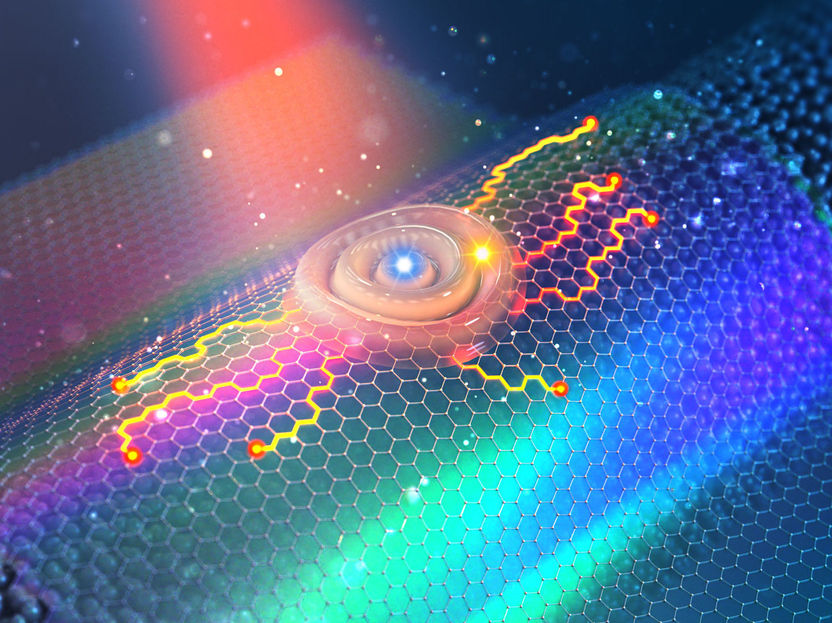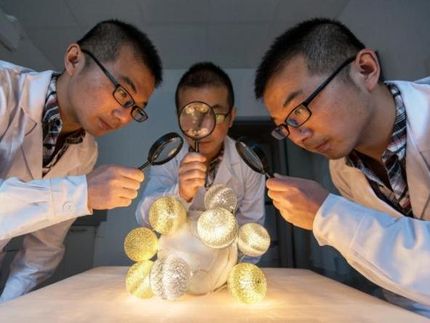„Crazy“ light emitters
Unusual quantum phenomenon discovered
A highly unusual movement of light emitting particles in atomically-thin semiconductors was experimentally confirmed by scientists from the Würzburg–Dresden Cluster of Excellence ct.qmat–Complexity and Topology in quantum matter. Electronic quasiparticles, known as excitons, seemed to move in opposite directions at the same time. Professor Alexey Chernikov–newly appointed physicist at the Technische Universität Dresden–and his team were able to reveal the consequences of this quantum phenomenon by monitoring light emission from mobile excitons using ultrafast microscopy at extremely low temperatures. These findings move the topic of quantum transport of excitonic many-body states into the focus of modern research. The results of this work have been published in the Physical Review Letters journal.

Illustration of an atomically-thin material layer stretched over a nanowire. It creates an energy channel for electronic quasiparticles, excited by light and guided along the channel. Their movement is made visible by ultrafast microscopy.
© Jörg Bandmann/ct.qmat
Light emitters in atomically-thin matter
Quantum materials studied by Alexey Chernikov and his team are only a few atoms thin. Due to extremely strong interactions in these systems, electrons come together to form new states known as excitons. Excitons behave like independent particles and are able to absorb and emit light with high efficiency. In atomically-thin layers they are stable from lowest temperatures such as minus 268 degree Celsius up to room temperature.
Regarding the current research project that focuses on the movement of excitons in ultra-thin matter, the physicist Chernikov explains: “Excitons can be understood as a kind of moving light sources. Like other quantum mechanical objects, they combine both wave and particle properties, propagating through atomically-thin crystals. It means that they can store and transport both energy and information, but also convert them again to light. That makes them particularly interesting for us."
On the trail of “crazy” quasiparticles
Rapid movement of excitons in atomically-thin semiconductors was visualized using highly sensitive optical microscopy: “First we applied a short laser pulse to the material that generated the excitons. Then we used an ultrafast detector to observe when and where the light was reemitted. When we repeated these experiments at very low temperatures, however, the movement of quasiparticles appeared rather astonishing,” says Chernikov.
Moving in two directions at the same time
So far, two general types of exciton movement were broadly known to the scientific community: either the excitons “jump” from one molecule to another (process known as hopping)–or they move rather “classically” like billiard balls that change their direction after random scattering events. “In the ultra-thin semiconductors, however, the excitons behaved in a way that we have never seen before. In the end, the only possible explanation was that the excitons would occasionally move through closed loops in opposite directions at the same time. Such behavior was in fact known from individual electrons. However, to observe this experimentally for luminescent excitons–that was quite unusual,” notes Chernikov.
After all control experiments confirmed the result, the scientists looked for the cause of their unusual observation. A recently published theoretical work by the Russian researcher Mikhail M. Glazov from the Ioffe Institute in Saint Petersburg provided the key insight: Glazov describes how excitons in atomically-thin semiconductors can indeed move through closed, ring-like paths and enter superimposed states. This means that the excitons seem to essentially move both clockwise and counterclockwise at the same time. This effect is a purely quantum mechanical phenomenon, which does not occur for classical particles. Together with the team of Ermin Malic from the Philipps University of Marburg, who provided additional insights into the exciton dynamics, the scientists were finally able to track down this unusual behavior.
Outlook
In a collaboration with international colleagues Alexey Chernikov's team has shown a way to experimentally monitor quantum mechanical effects in the movement of interacting many-particle complexes. Research into the quantum transport of excitonic quasiparticles, however, is still at the very beginning. In the future, materials such as the ultra-thin layers examined by Chernikov could also serve as a basis for new types of laser sources, light sensors, solar cells or even building blocks for quantum computers.




























































